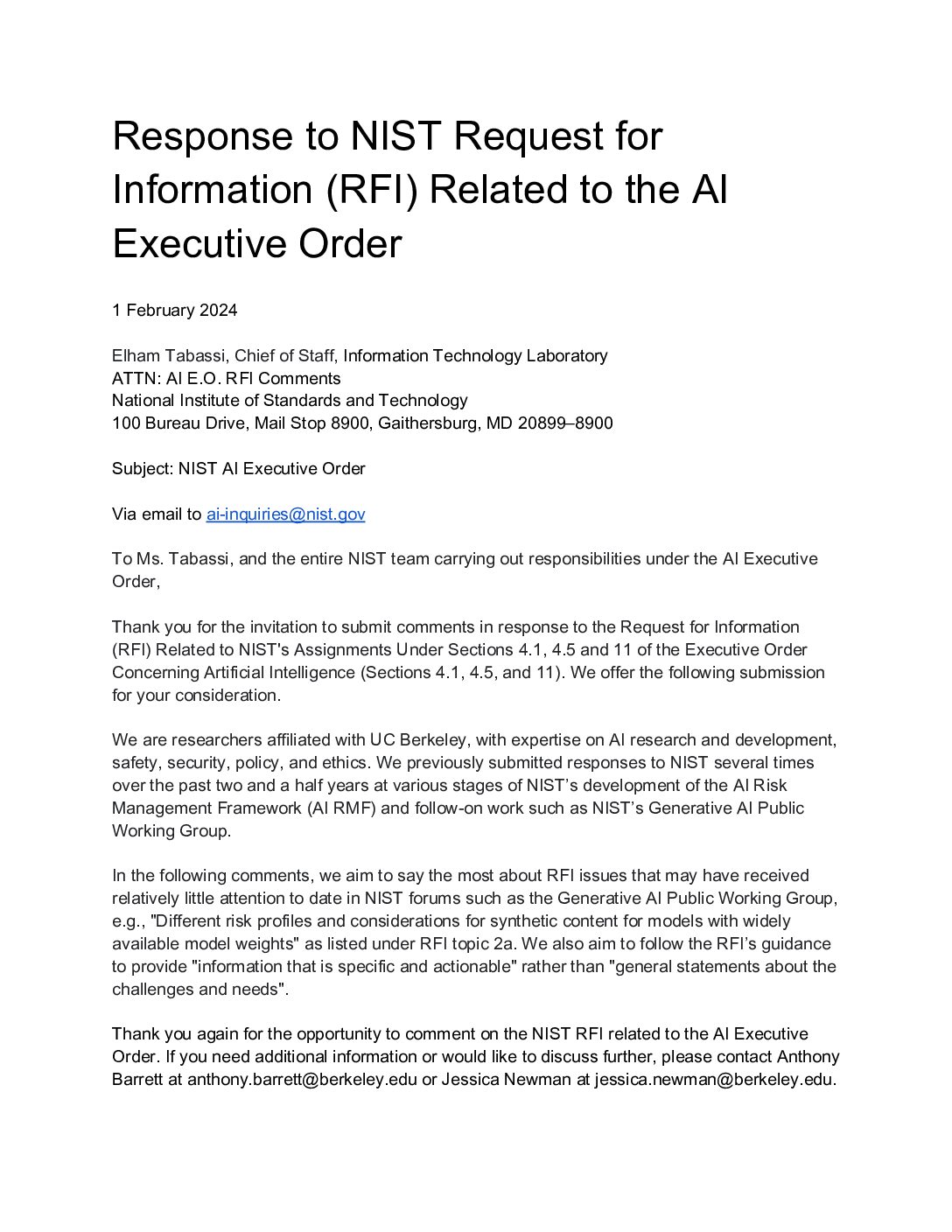On February 1, 2024, a group of researchers — affiliated with UC Berkeley — with expertise on AI research and development, safety, security, policy, and ethics submitted this formal response to the National Institute of Standards and Technology (NIST), in response to the Request for Information (RFI) Related to NIST’s Assignments Under Sections 4.1, 4.5 and 11 of the Executive Order Concerning Artificial Intelligence (Sections 4.1, 4.5, and 11).
This submission follows several responses to NIST over the past two and a half years at various stages of NIST’s development of the AI Risk Management Framework (AI RMF) and follow-on work such as NIST’s Generative AI Public Working Group.
In the following comments, the researchers aim to respond to RFI issues that may have received relatively little attention to date in NIST forums such as the Generative AI Public Working Group, e.g., “Different risk profiles and considerations for synthetic content for models with widely available model weights” as listed under RFI topic 2a. They also aim to follow the RFI’s guidance to provide “information that is specific and actionable” rather than “general statements about the challenges and needs”.
Our comments on specific items in the NIST RFI related to the AI Executive order
In the following, we list NIST RFI questions for which we provide answers, and omit NIST RFI questions that we do not specifically address.
1. Developing Guidelines, Standards, and Best Practices for AI Safety and Security
a. (1) Developing a companion resource to the AI RMF for generative AI
One resource that provides guidance and links to resources for identifying impacts of generative AI systems and mitigations for negative impacts is our own November 2023 publication, the UC Berkeley AI Risk-Management Standards Profile for General-Purpose AI Systems (GPAIS) and Foundation Models, Version 1.0 (see https://cltc.berkeley.edu/publication/ai-risk-management-standards-profile/). For over a year, we led development and testing of the profile, with input and feedback from more than 100 people representing a range of stakeholders, resulting in over 100 pages of guidance and accompanying material for developers of cutting edge GPAIS and foundation models. The profile is aligned with the NIST AI Risk Management Framework (AI RMF) and other AI standards such as ISO/IEC 23894. The Berkeley GPAIS and foundation model profile effort is separate from, but aims to complement and inform the work of, other guidance development efforts such as the NIST Generative AI Public Working Group.
The Berkeley GPAIS and foundation model profile discusses a wide variety of risks and harms of generative AI, highlights different roles for different AI actors (e.g., the role of AI developers vs. deployers), and discusses current techniques and implementations for managing risks and harms of generative AI, including the importance of documentation, reporting, and engagement.
2. Reducing the Risk of Synthetic Content, Topics under subsection (a):
Preventing generative AI from producing child sexual abuse material or producing non-consensual intimate imagery of real individuals (to include intimate digital depictions of the body or body parts of an identifiable individual); and Ability for malign actors to circumvent such techniques
According to the 2023 State of Deepfakes (see https://www.homesecurityheroes.com/state-of-deepfakes/) deepfake pornography makes up 98% of all deepfake videos online and 99% of the individuals targeted in deepfake pornography are women. These videos can be made for free in less than 25 minutes. The harms of non-consensual intimate imagery disproportionately impact women and girls of particular racial, ethnic, and religious backgrounds (see https://unesdoc.unesco.org/ark:/48223/pf0000387483/PDF/387483eng.pdf.multi). The UK Online Safety Act of 2023 prohibits the sharing of non-consensual deepfake pornography, but the US does not yet have a federal law to protect women and children from the harms of AI generated non-consensual intimate imagery. Unfortunately leading technical solutions such as watermarking, labeling, and authenticating provenance will do little to stop this, and so it will be particularly critical to support robust content moderation across media platforms to facilitate the rapid removal of exploitative and illegal content and to provide redress for those harmed, in addition to criminalizing the creation and intentional spreading of non-consensual intimate imagery including child sexual abuse material (CSAM).
Different risk profiles and considerations for synthetic content for models with widely available model weights
Foundation model developers that publicly release the model parameter weights for their models with downloadable, fully open, or open source access to their models, and other foundation model developers that suffer a leak of model weights, will in effect be unable to shut down or decommission AI systems that others build using those model weights. Moreover, direct access to model weights can also make it easier for malicious actors to remove or otherwise circumvent safeguards that a foundation model built into the original foundation model for the model’s release. These are considerations that should be weighed against the benefits of models with widely available parameter weights, especially for the largest-scale and most broadly capable models that pose the greatest risks of enabling severe harms, including from malicious misuse to harm the public. Many of the benefits of open source models, such as review and evaluation from a broader set of stakeholders, can be supported through transparency, engagement, and other openness mechanisms that do not require making a model’s parameter weights downloadable or open source, or by releasing smaller-scale and less broadly capable open source models.
Foundation model developers that plan to provide downloadable, fully open, or open source access to their models should first use a staged-release approach (e.g., not releasing parameter weights until after an initial closed source or structured access release where no substantial risks or harms have emerged over a sufficient time period), and should not proceed to a final step of releasing model parameter weights until a sufficient level of confidence in risk management has been established, including for safety risks and risks of misuse and abuse. (The largest-scale or most capable models should be given the greatest duration and depth of pre-release evaluations, as they are the most likely to have dangerous capabilities or vulnerabilities that can take some time to discover.)
We provide the above guidance, and related material, under Manage 2.4 of our AI Risk-Management Standards Profile for General-Purpose AI Systems (GPAIS) and Foundation Models, Version 1.0 (see https://cltc.berkeley.edu/publication/ai-risk-management-standards-profile/).
3. Advance Responsible Global Technical Standards for AI Development, Topics under subsection (a):
AI systems for which standards would be particularly impactful (e.g., because they are especially likely to be deployed or distributed across jurisdictional lines, or to need special governance practices)
Many regulatory requirements focus on specific industry sectors and end-use applications, e.g., in critical infrastructure or other high-risk categories of the draft EU AI Act. While valuable for downstream developers of end-use applications, an approach focused on end-use applications could overlook an opportunity to provide profile guidance for upstream developers of foundation models. Such AI systems can have many uses, and early-development risk issues such as emergent properties that upstream developers are often in a better position to address than downstream developers building on AI platforms for specific end-use applications.
Guidelines and standards for trustworthiness, verification, and assurance of AI systems
In our research, documented for example in A Taxonomy of Trustworthiness for Artificial Intelligence (see: https://cltc.berkeley.edu/publication/a-taxonomy-of-trustworthiness-for-artificial-intelligence-standalone-taxonomy/) we have found that many considerations related to the safe and trustworthy development of AI systems are best addressed during the early design and development stages of the AI lifecycle. Solely focusing on end-use and on the deployers of AI systems misses the importance for example of standards for privacy and security by design, for data quality and curation, and for testing and evaluation of general capabilities and vulnerabilities.





